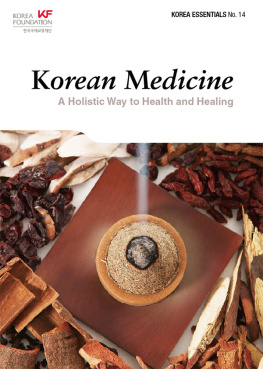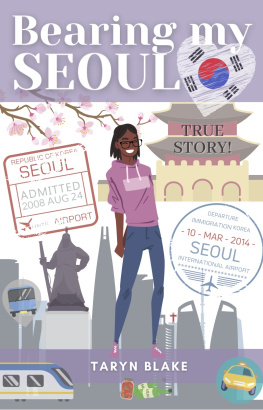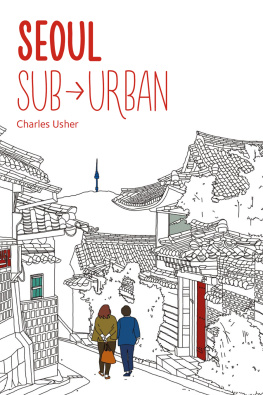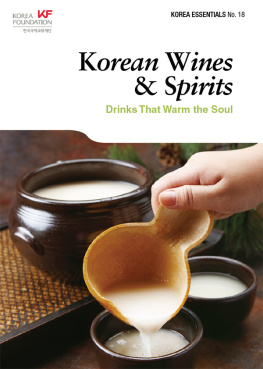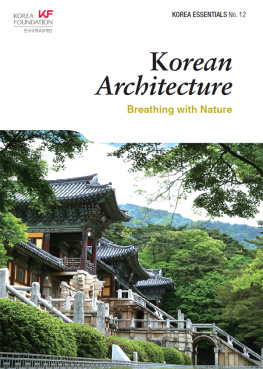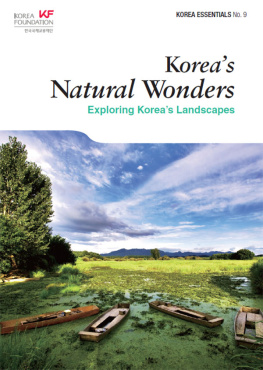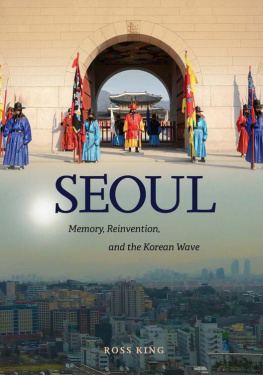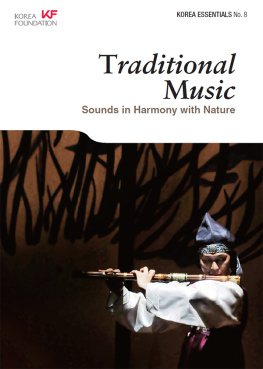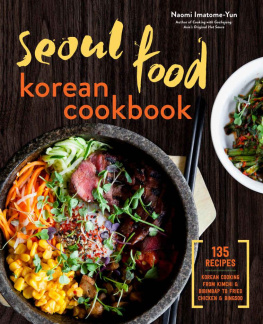Seoul Selection - Korean Medicine
Here you can read online Seoul Selection - Korean Medicine full text of the book (entire story) in english for free. Download pdf and epub, get meaning, cover and reviews about this ebook. year: 2015, publisher: Seoul Selection, genre: Religion. Description of the work, (preface) as well as reviews are available. Best literature library LitArk.com created for fans of good reading and offers a wide selection of genres:
Romance novel
Science fiction
Adventure
Detective
Science
History
Home and family
Prose
Art
Politics
Computer
Non-fiction
Religion
Business
Children
Humor
Choose a favorite category and find really read worthwhile books. Enjoy immersion in the world of imagination, feel the emotions of the characters or learn something new for yourself, make an fascinating discovery.
- Book:Korean Medicine
- Author:
- Publisher:Seoul Selection
- Genre:
- Year:2015
- Rating:4 / 5
- Favourites:Add to favourites
- Your mark:
- 80
- 1
- 2
- 3
- 4
- 5
Korean Medicine: summary, description and annotation
We offer to read an annotation, description, summary or preface (depends on what the author of the book "Korean Medicine" wrote himself). If you haven't found the necessary information about the book — write in the comments, we will try to find it.
Korean Medicine — read online for free the complete book (whole text) full work
Below is the text of the book, divided by pages. System saving the place of the last page read, allows you to conveniently read the book "Korean Medicine" online for free, without having to search again every time where you left off. Put a bookmark, and you can go to the page where you finished reading at any time.
Font size:
Interval:
Bookmark:
Korean Medicine
A Holistic Way to Health and Healing
 |  |
KOREA ESSENTIALS No. 14
Korean Medicine:A Holistic Way to Health and Healing
Copyright 2013 by The Korea Foundation
All Rights Reserved.
No part of this book may be reproduced or utilized in any form or by any means without the written permission of the publisher.
Published in 2013 by Seoul Selection
B1 Korean Publishers Association Bldg., 105-2 Sagan-dong, Jongno-gu,
Seoul 110-190, Korea
Phone: (82-2) 734-9567
Fax: (82-2) 734-9562
Email:
Website: www.seoulselection.com
ISBN: 978-1-62412-052-7
INTRODUCTION
Korean traditional medicine has long been an important part of Korean culture. Many years before Western medicine arrived in the country, it was used to cure and prevent diseases. Korean traditional medicine went through a period of decline in attention and importance after the arrival of Western medicine, but that has been changing in recent years. More people around the world are growingly aware of the limits of the Western approach and turning to alternative forms of medicine. The U.S. alone has 50 colleges of Oriental medicine, with more to be found in European countries. Interest in acupuncture and herbal treatments is soaring, and as the effectiveness of Korean traditional medicine gets more well known, the numbers of foreigners flocking to clinics has steadily risen.
This book explores Korean traditional medicine in six chapters, examining everything from its origins to present-day forms and potential. In addition to its differences from Western medicine, the basic principles used to understand the patient and diseases will be looked at. Methods of diagnosis and treatment will also be explored. Many know of acupuncture, moxibustion, and herbal remedies, but there are also many other methods; cupping, chuna, aromatherapy, and taping, to name just a few. The book also examines how Korean traditional medicine can be applied to specific conditions and situations, from the common cold to menopausal symptoms, headaches, depression and anger management, fatigue, pregnancy and childbirth, postpartum treatment, and even hair loss. Finally, the last section will describe how Korean traditional medicine is moving beyond Koreas borders to reach people all around the world. Interspersed with all of this are brief sidebars on topics such as Donguibogam, a text known as the bible of Korean traditional medicine; sasang (four physical constitutions) medicine, a unique concept that sets the Korean approach apart from other forms of Oriental medicine; the use of acupuncture in the ear to help people quit smoking; steam bidet therapy used to apply herbal treatment externally; Koreas storied herbal markets; and the most frequently used herbs.
The intent of this book is to help Korean traditional medicine become more accessible to foreign readers and help people around the world live a more healthy, disease-free life thanks to Koreas outstanding medical know-how.
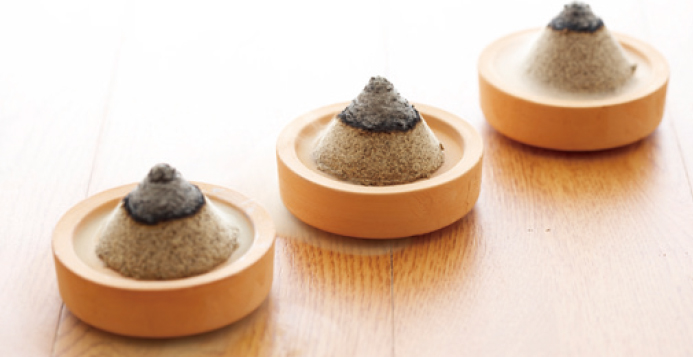
Korean medicine is the official English-language name for haneuihak as designated by the Association of Korean Medicine and the Korean Medicine Hospitals Association. This book uses the term Korean traditional medicine to avoid confusion with Western medicine as practiced in Korea.
The physician should not treat the disease but the patient who is suffering from it.
Maimonides

ORIGINS AND HISTORY
Korean traditional medicine has developed with the Korean people, and is a product of their collective wisdom. Although ancient Koreans are known to have learned much from neighboring countries such as China, they developed their own medicine better suited to their lifestyle and physical constitution rather than simply following the Chinese model.
Ancient Times
From the time the first people arrived on the Korean Peninsula, Koreans have continuously developed and refined their medical knowledge. Early on, this was related mainly to remedial treatment such as easing pain or tending to injury, along with knowing what foods were good for health. In particular, due to its powerful influence, nature became an object of worship and ritual practices. This animistic belief later evolved into shamanism, which reinforced the notion that all things have a spirit. Related to this, a physical ailment was thought to be caused by the influence of evil spirits, for which a shaman was needed to provide a remedy.
Evidence of ancient Korean medicine can be found in the Dangun myth, in which mugwort and garlic were prescribed. The Dangun creation myth, which is said to recount the origin of the Korean people, was recorded in several historical journals, including Memorabilia of the Three Kingdoms (Samgukyusa), which was written during the Goryeo Dynasty period (9181392). This account of the birth of the original Korean nation, Old Joseon (2333108 B.C.), tells of a bear and tiger who, after appealing to the gods to allow them to take on human form, were told to eat mugwort and garlic.
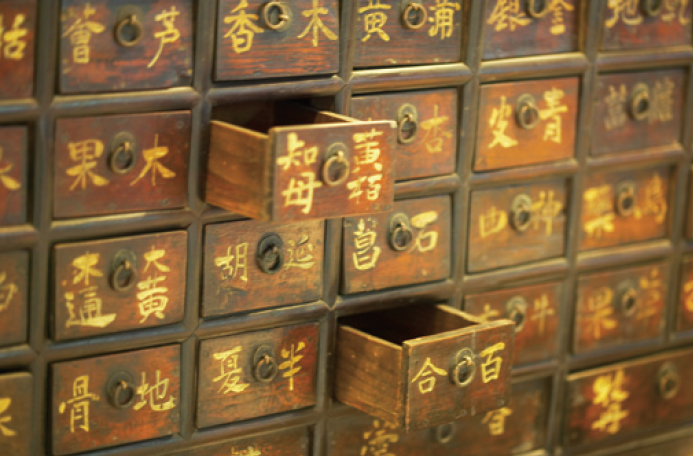
Medicine chest with names indicating which medicine goes in each drawer
This provides insight into how ancient Koreans recognized the efficacy of herbal medicine. Even the foremost Chinese medical journal, Shen Nong Ben Cao Jing (Shen Nong Materia Medica), contained no reference to mugwort or garlic. Compiled in the Later Han Dynasty (25220) and the Three Kingdoms period (220280) of China, this journal describes the uses for 365 medicines. The lack of any reference to mugwort or garlic seems to verify the independent development of Korean traditional medicine.
In Koreas Three Kingdoms period (57 B.C. A.D. 668), significant exchanges were conducted with other countries, to the point that such foreign influences eventually permeated Korean culture and medicine. In particular, medical knowledge from China and India supplemented the foundation of traditional medicine in Korea that had been handed down from the Old Joseon period, which spurred further development.
This trend continued into the Unified Silla period (676935), with Korean medicine being blended with those of China and India and then localized. In the Goryeo period (9181392), a variety of medicinal ingredients were introduced to Korea by Chinas Song Dynasty (9601279) as well as Arab merchants, and this contributed to the expansion of Koreas medical knowledge.
Origins of the Korean Approach
Korea began to establish a truly unique form of traditional medicine in the Goryeo Dynasty period due primarily to the lack of development of Chinese medicine after the founding of the Yuan Dynasty (12711368) and subsequent decline in the value of Sino-Korean medical exchanges. So a Korean form of medicine tailored to Koreas conditions began to thrive, and this included the publication of medical journals, such as Jejungiphyobang (An Introductory Guide to Medicine for the General Public), Eouichwal yobang (The Essential Guide to Mastering Medicine), and Hyangyakgugeupbang (Guide to Korean Medicine and First Aid). These publications included medical knowledge from Chinas Song and Yuan dynasties and elsewhere, but also documented extensive research findings of medicinal ingredients indigenous to Korea. They also showed the significant advancement of Korean traditional medicine from the Old Joseon period.
Next pageFont size:
Interval:
Bookmark:
Similar books «Korean Medicine»
Look at similar books to Korean Medicine. We have selected literature similar in name and meaning in the hope of providing readers with more options to find new, interesting, not yet read works.
Discussion, reviews of the book Korean Medicine and just readers' own opinions. Leave your comments, write what you think about the work, its meaning or the main characters. Specify what exactly you liked and what you didn't like, and why you think so.

